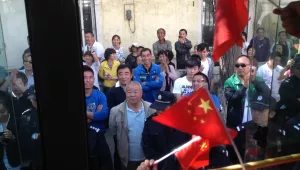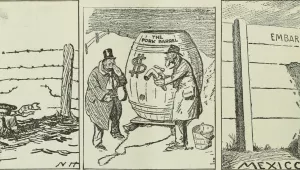Introduction
The post-revolutionary state in Iran is an intriguingly complex political system. Constituted of a series of composite institutional arrangements with competing roles, the Iranian state is a hybrid of both democratic and theocratic institutions. Presidential elections, however constrained by the theocratic components of the political system, determine who will seize the halls of power. Since 2013, Iranian President Hassan Rouhani—who has much more in common with the reformists than the conservatives—won elections twice. During both elections, his campaign ran on the platform of “prudent moderation and hope.”
To be sure, Hassan Rouhani succeeded in delivering some of his promises to the nation. He forged the landmark nuclear deal with the West and managed to jump-start a significant economic recovery in Iran by dismantling some of his predecessor’s ill-advised populist economic policies and adopting a slew of new economic strategies. As a result, from a negative growth rate of -6.6% in 2012, Iran’s GDP grew by 7.2% in 2016 and by 12.5% in 2017. While the growth rates have been mostly the result of a massive increase in oil and gas production by a staggering 62% due to sanctions relief, they push Iran to the front ranks of the developing world in terms of GDP growth. But if the Rouhani government succeeded in restoring growth and reducing inflation from 35% to 10%, why did a widespread wave of protests, fueled by economic hardships and especially youth unemployment, sweep over Iran?
Recent Protests and Factional Economic Policies
The recent protests in Iran cannot be understood in isolation from the factional economic policies of the state. Hassan Rouhani, unlike his conservative predecessor Mahmoud Ahmadinejad, put his faith in bolstering economic development by raising aggregate investments in the private sector for long-term growth, as opposed to relying on cash transfers and populist redistribution policies. This was apparent in the $337 billion budget proposal that he submitted to the Iranian Parliament in early December last year, in which austerity measures were introduced, including a significant cut in the popular unconditional basic income program.
Started in 2011 by conservative President Mahmoud Ahmadinejad, the unconditional basic income program granted every Iranian a stipend of about $90 per month, largely financed by the savings from the energy subsidy reforms. Rouhani never looked favorably on this program since his election to office in 2013. He believed that the state, instead of distributing largess among the working class to win their short-term support, should induce growth and dynamism in the private sector by attracting foreign investment to raise people’s standards of living on aggregate scale. In a recent budget proposal to the parliament, he cut the funding for the program by more than half. He did not propose to cut the amount of cash transfers, but he suggested a cut in the number of recipients, so that cash transfers would be allotted to the lower deciles of income bracket. This already by mid-December last year had raised a controversy and was hotly debated in domestic media. Adding to this was the announcement that the price of gasoline would be 50% higher for the next year, which caused enormous outrage in the country—especially among low-income households.
It should not go unnoticed that the recent protests, though almost completely subdued over the past week, were pointedly different from previous ones namely, the post-2009 election protests. The recent unrests were different in two important ways: 1) the provincial size; 2) the geography. Sporadic and geographically dispersed across the country, often with a small number of protestors (the highest estimate this time around being only 45,000 people), they stand in glaring contrast to the millions that took to the street during the post-2009 election protests. Historically, major protests in Iran took place in the country’s capital city of Tehran, as well as other big cities in the provinces. These protests, however, took place in small villages and obscure venues, which signifies that the protestors were largely poor, low-income Iranians who had legitimate grievances over economic hardships, particularly from the price inflation of basic foodstuff and youth unemployment. There are reports that urbanized middle-class citizens, including the reformists who were previously active in such demonstrations, refrained from partaking in the protests. Their eschewal to participate does not suggest that the middle-class has no grievances, but perhaps, wishes to avoid risking the country’s stability in the most troubled region of the world.
No Windfall from Nuclear Deal in Non-Oil Sectors
When sanctions—including the ban on oil and gas exports—were lifted in late December 2015, oil revenues soared and growth rates were restored. But this did not solve the country’s unemployment problem. While Iran has some respectable manufacturing sectors such as auto, steel, rubber, mining, and pharmaceuticals, and boasts significant competence in cutting-edge industries such as aerospace, nanotechnology, and stem cells, the economy is still dependent on oil and gas revenues for public and social spending. Since the oil and gas industries are highly technological and capital-intensive, they do not generate ample employment for Iran’s young population. Once Iran sealed the nuclear deal, the expectations were that there would be an inflow of foreign investment in non-oil and labor-intensive industries of the economy to boost employment.
Despite many attempts, the Rouhani government’s performance in attracting foreign investment in the non-oil sectors fell far short of its target. This can, at least in part, be blamed on the Trump Administration, which made every effort to sabotage the Iran Nuclear Deal. Fearing that Donald Trump could walk away from the deal at any point in future, many European banks and firms who would otherwise be keen to invest in Iran became afraid to do so. While there have been some major foreign direct investments in the oil and gas sectors by companies such as France’s Total, Italy’s Eni, the Netherland’s Shell, Russia’s Lukoil, and China National Petroleum (CNPC), the non-oil sector—where jobs are created—has not witnessed much direct foreign investment.
The recent protests in Iran are surely a wakeup call for President Rouhani. To respond the legitimate grievances of low-income Iranian households, the Rouhani government should do its best to further diversify the Iranian economy and to bolster its manufacturing and industrial sectors. The Rouhani government should also promote the export of non-oil products, following the models of countries such as South Korea, Taiwan, and recently, the Chinese leviathan. Labor-intensive industries as well as service sectors like information technology, ought to be solidified. Rouhani should call upon state-directed industrial committees and agencies to provide Iranian entrepreneurs and manufacturers with fiscal resources, and he should foster financial support and protection for firms that place emphasis on exporting goods abroad.
In short, to improve the living standards of Iranian working class and to realize the country’s sixth development plans and ambitions, the administration must look beyond oil. And it must make the most use possible of the country’s industrial base and its young skilled labor force.
Masoud Movahed is a doctoral candidate at the University of Wisconsin-Madison. He contributes to, among others, Foreign Affairs, Harvard Economic Review, Harvard International Review, Yale Journal of International Affairs, World Economic Forum and Aljazeera English.
Movahed , Masoud . “A Wake-up Call to Rouhani.” January 17, 2018


